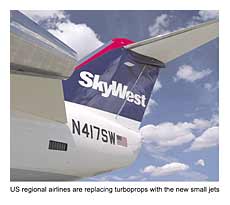|
Crossing the great jet divide
|
 |
June 9, 2000: 10:18 a.m. ET
From bars in the sky to long queues at the exit, air travel is set to change
By Staff Reporter Doug Cameron
|
LONDON (CNNfn) - The glossy brochures on display at the Farnborough International Air Show near London in July will tell one side of the unfolding story of the future of air travel.
On paper at least, the new range of super-jumbo jets due to come into service in 2005 have echoes of the old luxury jetliners which crossed the Atlantic in the 1950s when a one-way ticket cost two months of average wages.
Real ticket prices have fallen every year since jets replaced propellers, and so has the flying experience, which most passengers equate to a mixture of boredom, cramped legs and bad food.
 When American Airlines decided to rip out 7,200 seats from their fleet last year, boosting legroom in coach to 35 inches from 31, passengers must have felt like the laws of airline economics were working in their favor. When American Airlines decided to rip out 7,200 seats from their fleet last year, boosting legroom in coach to 35 inches from 31, passengers must have felt like the laws of airline economics were working in their favor.
Maybe, but maybe not.
The one certainty is that there will be more planes in the sky, and, with air traffic control systems already creaking, more delays to contend with. With passenger numbers rising by almost 5 percent a year, Boeing, the world's largest commercial aircraft producer, predicts that airlines will need almost 20,000 new aircraft by 2020, including 4,000 to replace ageing jets.
The aircraft market is fragmenting. At one end, Europe's Airbus Industrie is set to decide this month whether to press ahead with its 550-seat A3XX, a third larger than the Boeing 747 jumbo jets which dominate the world's busiest routes.
 Boeing and Airbus are locked in a bitter dispute over the viability of larger aircraft. Airbus argues that growth and congestion will create a market for around 1,200 ultra-large aircraft over the next 15 years. But Boeing argues the demand will be for smaller planes that can fly farther. Boeing and Airbus are locked in a bitter dispute over the viability of larger aircraft. Airbus argues that growth and congestion will create a market for around 1,200 ultra-large aircraft over the next 15 years. But Boeing argues the demand will be for smaller planes that can fly farther.
"We think the market is heading towards more point-to-point service," Phil Condit, Boeing's chief executive, told CNNfn this week. He puts demand for ultra-large aircraft at less than 500 over the next 20 years. "You as the passenger want to get where you want to go, and that's not necessarily through a hub."
 Boeing is looking to extend the 747 to around 500 seats at some point but is focusing on boost the size and range of its 777 wide body jet, which has less passenger capacity than the 747, but which would be able to fly 10,100 miles, enough to fly non-stop from Kuala Lumpur, Malaysia, to New York, on an 18-hour flight. Boeing is looking to extend the 747 to around 500 seats at some point but is focusing on boost the size and range of its 777 wide body jet, which has less passenger capacity than the 747, but which would be able to fly 10,100 miles, enough to fly non-stop from Kuala Lumpur, Malaysia, to New York, on an 18-hour flight.
Regional jets take the strain
The fastest-growing part of the aircraft market is that for small jets, ranging in size from 50 to 120 seats. They have become a familiar feature of short-stop flights in the United States and, increasingly, Europe.
The planned launch of more models in this sector, with between 30 and 90 seats, is expected to spell the end of propellers planes in developed airline markets.
The regional jet aircraft made by Canada's Bombardier and Brazil's Embraer have become the private jets of the masses, increasingly replacing propeller aircraft and a hit with travelers who prefer their speed and are more reassured by the throb of a jet engine over whirring prop blades. Boeing has its own 717 now in production, its newest commercial jet that holds 106 passengers.
 The only critics are the pilots who, particularly in the United States, have sought to block the introduction of jets with fewer than 50 seats, fearing a large-scale switch from larger jets - which attract bigger salaries. The so-called "scope clauses" in pilots' contracts have slowed the introduction of regional jets. The only critics are the pilots who, particularly in the United States, have sought to block the introduction of jets with fewer than 50 seats, fearing a large-scale switch from larger jets - which attract bigger salaries. The so-called "scope clauses" in pilots' contracts have slowed the introduction of regional jets.
Analysts believe that these issues will take years to resolve.
There are two possibilities for travelers faced with a new era of ultra-large aircraft. The brochures produced by Airbus, and more discreetly by Boeing, show a return to the flying-boat culture of extra legroom, on-board bars and shops, beds and even gyms. Everything but showers, with the weight of the water required deemed to burn too much fuel to make economic sense.
The other extreme envisions airlines using the likes of the A3XX to transport low-value coach-class passengers between major hubs, using the extra room to pack 'em in, with inevitable lengthy waits in getting on and off the aircraft at either end. Business passengers will be given the run of smaller jets, with all the room their higher ticket prices can buy.
Jets are becoming larger and smaller, with all the gaps in between filled by new models to give airlines flexibility to adapt to individual route patterns. With new noise end exhaust standards coming into force over the next few years, as much work is going into meeting the rules as is going into redefining air travel in terms of, say, another bash at the Concorde dream of supersonic travel for all. 
|
|
|
|
|
 |

|

